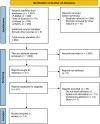Spinal Cord Stimulation for Poststroke Hemiparesis: A Scoping Review
- PMID: 38477681
- PMCID: PMC11017736
- DOI: 10.5014/ajot.2024.050533
Spinal Cord Stimulation for Poststroke Hemiparesis: A Scoping Review
Abstract
Importance: Spinal cord stimulation (SCS) is a neuromodulation technique that can improve paresis in individuals with spinal cord injury. SCS is emerging as a technique that can address upper and lower limb hemiparesis. Little is understood about its effectiveness with the poststroke population.
Objective: To summarize the evidence for SCS after stroke and any changes in upper extremity and lower extremity motor function.
Data sources: PubMed, Web of Science, Embase, and CINAHL. The reviewers used hand searches and reference searches of retrieved articles. There were no limitations regarding publication year.
Study selection and data collection: This review followed the Preferred Reporting Items for Systematic reviews and Meta-Analyses extension for Scoping Reviews (PRISMA-ScR) checklist. The inclusion and exclusion criteria included a broad range of study characteristics. Studies were excluded if the intervention did not meet the definition of SCS intervention, used only animals or healthy participants, did not address upper or lower limb motor function, or examined neurological conditions other than stroke.
Findings: Fourteen articles met the criteria for this review. Seven studies found a significant improvement in motor function in groups receiving SCS.
Conclusions and relevance: Results indicate that SCS may provide an alternative means to improve motor function in the poststroke population. Plain-Language Summary: The results of this study show that spinal cord stimulation may provide an alternative way to improve motor function after stroke. Previous neuromodulation methods have targeted the impaired supraspinal circuitry after stroke. Although downregulated, spinal cord circuitry is largely intact and offers new possibilities for motor recovery.
Copyright © 2024 by the American Occupational Therapy Association, Inc.
Figures

Similar articles
-
Sensory-Based Priming for Upper Extremity Hemiparesis After Stroke: A Scoping Review.OTJR (Thorofare N J). 2022 Jan;42(1):65-78. doi: 10.1177/15394492211032606. Epub 2021 Jul 26. OTJR (Thorofare N J). 2022. PMID: 34311607 Free PMC article.
-
Poststroke arm and hand paresis: should we target the cervical spinal cord?Trends Neurosci. 2022 Aug;45(8):568-578. doi: 10.1016/j.tins.2022.05.002. Epub 2022 May 31. Trends Neurosci. 2022. PMID: 35659414 Review.
-
Impact of the combination of virtual reality and noninvasive brain stimulation on the upper limb motor function of stroke patients: a systematic review and meta-analysis.J Neuroeng Rehabil. 2024 Oct 5;21(1):179. doi: 10.1186/s12984-024-01474-y. J Neuroeng Rehabil. 2024. PMID: 39369259 Free PMC article.
-
Effect of aerobic exercise prior to modified constraint-induced movement therapy outcomes in individuals with chronic hemiparesis: a study protocol for a randomized clinical trial.BMC Neurol. 2019 Aug 15;19(1):196. doi: 10.1186/s12883-019-1421-4. BMC Neurol. 2019. PMID: 31416436 Free PMC article. Clinical Trial.
-
Effectiveness of Activity-Based Task-Oriented Training on Upper Extremity Recovery for Adults With Stroke: A Systematic Review.Am J Occup Ther. 2024 Mar 1;78(2):7802180070. doi: 10.5014/ajot.2024.050391. Am J Occup Ther. 2024. PMID: 38393992
Cited by
-
Electromyography (EMG)-triggered transcutaneous spinal cord and hip stimulation for gait rehabilitation in persons with chronic stroke: a randomized, controlled trial.J Neuroeng Rehabil. 2025 Jul 7;22(1):154. doi: 10.1186/s12984-025-01690-0. J Neuroeng Rehabil. 2025. PMID: 40624543 Free PMC article. Clinical Trial.
-
The effect of unaffected side resistance training on upper limb function reconstruction and prevention of sarcopenia in stroke patients: a randomized controlled trial.Sci Rep. 2024 Oct 25;14(1):25330. doi: 10.1038/s41598-024-76810-2. Sci Rep. 2024. PMID: 39455849 Free PMC article. Clinical Trial.
-
Quantitative Evaluation of Postural SmartVest's Multisensory Feedback for Affordable Smartphone-Based Post-Stroke Motor Rehabilitation.Int J Environ Res Public Health. 2025 Jun 28;22(7):1034. doi: 10.3390/ijerph22071034. Int J Environ Res Public Health. 2025. PMID: 40724102 Free PMC article.
References
-
- Ang, K. K., Chua, K. S., Phua, K. S., Wang, C., Chin, Z. Y., Kuah, C. W., et al. . Guan, C. (2015). A randomized controlled trial of EEG-based motor imagery brain–computer interface robotic rehabilitation for stroke. Clinical EEG and Neuroscience, 46, 310–320. 10.1177/1550059414522229 - DOI - PubMed
-
- Ang, K. K., Guan, C., Phua, K. S., Wang, C., Teh, I., Chen, C. W., & Chew, E. (2012). Transcranial direct current stimulation and EEG-based motor imagery BCI for upper limb stroke rehabilitation. Annual International Conference of the IEEE Engineering in Medicine and Biology Society, 2012, 4128–4131. 10.1109/EMBC.2012.6346875 - DOI - PubMed
-
- August, K., Lewis, J. A., Chandar, G., Merians, A., Biswal, B., & Adamovich, S. (2006). FMRI analysis of neural mechanisms underlying rehabilitation in virtual reality: Activating secondary motor areas. In 2006 International Conference of the IEEE Engineering in Medicine and Biology Society (pp. 3692–3695). Institute of Electrical and Electronics Engineers. 10.1109/IEMBS.2006.260144 - DOI - PubMed
-
- *Awosika, O. O., Matthews, S., Staggs, E. J., Boyne, P., Song, X., Rizik, B. A., et al. Kissela, B. M. (2020). Backward locomotor treadmill training combined with transcutaneous spinal direct current stimulation in stroke: A randomized pilot feasibility and safety study. Brain Communications, 2, fcaa045. 10.1093/braincomms/fcaa045 - DOI - PMC - PubMed
Publication types
MeSH terms
Grants and funding
LinkOut - more resources
Full Text Sources
Medical
Miscellaneous

